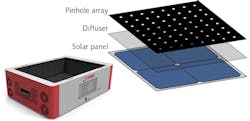Flux and color of LED luminaires are typically measured using an integrating sphere. Unfortunately, the sphere must be recalibrated frequently and self-absorption calibration is needed to account for the absorption by the LED device itself, not to mention that the sphere must be at least three times the size of the fixture to make an accurate measurement. But an alternative approach from Ophir-Spiricon (Logan, UT), a MKS Instruments company, requires only one calibration and can accommodate LED luminaires the same size as the measuring instrument itself.
Smaller, lighter, and less expensive than a comparable integrating sphere, FluxGage uses an array of photovoltaic absorbers, with each absorber consisting of photovoltaic cells sandwiched under a sheet diffuser covered with a black-ink-coated dense array of pinholes to better distribute the collected light and minimize reflections, making it insensitive to size and beam angle. A fiber-optic sensor delivers light to a spectrometer inside the system and a fast photodiode measures flicker. FluxGage measures total flux to an uncertainty of 6% and color parameters, including correlated color temperature (CCT), color rendering index (CRI), and chromaticity. Experimental measurements from an integrating sphere vs. FluxGage for LED luminaires with total flux values from 1000 to 30,000 lumens and CCT values between 2700 and 5700 K saw differences of only 1% in CCT and 1.5% in total flux. Reference: www.ophiropt.com/led/technology.

